The Tribological Properties of 30CrMnSiA Bearing Steels Treated by the Strengthening Grinding Process under Lubrication Wear
Abstract
1. Introduction
2. Materials and Methods
2.1. Materials
2.2. Strengthening Grinding Process and Surface Treatment of Samples
2.3. Friction and Wear Testing
2.4. Characterization
3. Results
3.1. Surface Morphology
3.2. Friction Coefficients
3.3. Wear Volume and Specific Wear Rate
3.4. Wear Morphology
4. Discussion
5. Conclusions
- (1)
- The strengthening grinding process (SGP) is an effective method to enhance the wear resistance of 30CrMnSiA. Due to numerous micropits on the processed surface treated by SGP, the micropits are comparable to microscopic oil pockets that store lubricants during lubrication and friction, which enhance the surface lubrication properties. The SGP also causes grain refinement in the surface layer, raising the surface hardness of the samples.
- (2)
- At the conditions of the text experiment, the oil storage capacity of the microscopic oil pockets, the surface hardness, and the surface roughness of the sample are all positively correlated with the jet angle of SGP as the jet angle increases from 0° to 90°, and the running-in time of the tested sample increases, mainly due to the increased roughness of the processed surface. Following steady wear, the friction coefficient, the wear volume, and the specific wear rate of the tested samples demonstrate a rapid decrease, then a slight decrease, and then a slow increase. In addition, the average friction coefficient, wear volume, and wear rate of the samples tested are minimized when the jet angle of the SGP is 60°.
- (3)
- In the lubrication and friction test, the wear mechanism of the control sample (0°) is mainly characterized by severe abrasive wear and slight fatigue wear. When the jet angle of the SGP is 30°, the wear mechanism of the tested sample is mainly slight abrasive wear and severe fatigue wear. As the jet angle of the SGP is increased to 60°, the wear mechanism of the tested sample shifts to abrasive wear. At a jet angle of 90°, the wear mechanism shifts back to wear by abrasive and fatigue wear.
- (4)
- In this study, when the jet angle ranges from 0° to 60°, a large number of microscopic oil pockets and the increased hardness were the main reasons for the enhanced wear resistance of the processed surfaces. When the jet angle is 90°, the excessive roughness causes the oil film on the surface to be severely damaged, further leading to a reduction in the lubrication properties of the processed surface and ultimately to the reduced wear resistance of the sample.
Author Contributions
Funding
Institutional Review Board Statement
Informed Consent Statement
Data Availability Statement
Acknowledgments
Conflicts of Interest
References
- Zhou, J.S.; Zhen, L.; Yang, D.Z.; Li, H.T. Macro- and microdamage behaviors of the 30CrMnSiA steel impacted by hypervelocity projectiles. Mater. Sci. Eng. A 2000, 282, 177–182. [Google Scholar] [CrossRef]
- Liu, T.; Shi, X.; Zhang, J.; Fei, B. Crack initiation and propagation of 30CrMnSiA steel under uniaxial and multiaxial cyclic loading. Int. J. Fatigue 2019, 122, 240–255. [Google Scholar] [CrossRef]
- Liu, T.; Qi, X.; Shi, X.; Zhang, T.; Zhang, G.; Zhang, J. Crack growth path of 30CrMnSiA steel under variable amplitude multiaxial loading. Int. J. Fatigue 2021, 153, 106502. [Google Scholar] [CrossRef]
- Liu, J.; Shi, J.; Li, S. Effects of Electroplated Coatings on Corrosion Behavior of Ti-1023/30CrMnSiA Galvanic Couple. J. Wuhan Univ. Technol.-Mater. Sci. Ed. 2008, 23, 704–707. [Google Scholar] [CrossRef]
- Kong, Y.; Liu, Z.; Liu, Q. Effect of Laser Power on Microstructure and Properties of Ni-based Alloy Coatings on 30CrMnSiA Steel. J. Therm. Spray Technol. 2022, 31, 2136–2146. [Google Scholar]
- Kango, S.; Singh, D.; Sharma, R.K. Numerical investigation on the influence of surface texture on the performance of hydrodynamic journal bearing. Meccanica 2012, 47, 469–482. [Google Scholar] [CrossRef]
- Luo, J.; Liu, M.; Ma, L. Origin of friction and the new frictionless technology-Superlubricity: Advancements and future outlook. Nano Energy 2021, 86, 106092. [Google Scholar] [CrossRef]
- Liu, H.; Yang, B.; Wang, C.; Han, Y.; Liu, D. The mechanisms and applications of friction energy dissipation. Friction 2022. [Google Scholar] [CrossRef]
- Berman, D.; Erdemir, A.; Sumant, A.V. Approaches for Achieving Superlubricity in Two-Dimensional Materials. ACS Nano 2018, 12, 2122–2137. [Google Scholar] [CrossRef] [PubMed]
- Findik, F. Latest progress on tribological properties of industrial materials. Mater. Des. 2014, 57, 218–244. [Google Scholar] [CrossRef]
- Wang, L.; Nie, X.; Lukitsch, M.J.; Jiang, J.C.; Cheng, Y.T. Effect of tribological media on tribological properties of multilayer Cr(N)/C(DLC) coatings. Surf. Coat. Technol. 2006, 201, 4341–4347. [Google Scholar] [CrossRef]
- Luo, J.; Wang, N.; Zhu, L.; Wu, G.; Li, L.; Yang, M.; Zhang, L.; Chen, Y. Tribological Properties of Ni/Cu/Ni Coating on the Ti-6Al-4V Alloy after Annealing at Various Temperatures. Materials 2020, 13, 847. [Google Scholar] [CrossRef] [PubMed]
- Yan, M.; Wang, Y.; Chen, X.; Guo, L.; Zhang, C.; You, Y.; Bai, B.; Chen, L.; Long, Z.; Li, R. Laser quenching of plasma nitrided 30CrMnSiA steel. Mater. Des. 2014, 58, 154–160. [Google Scholar] [CrossRef]
- Han, X.; Zhang, Z.; Hou, J.; Barber, G.C.; Qiu, F. Tribological behavior of shot peened/austempered AISI 5160 steel. Tribol. Int. 2020, 145, 106197. [Google Scholar] [CrossRef]
- Dang, J.; Zhang, H.; An, Q.; Lian, G.; Li, Y.; Wang, H.; Chen, M. Surface integrity and wear behavior of 300M steel subjected to ultrasonic surface rolling process. Surf. Coat. Technol. 2021, 421, 127380. [Google Scholar] [CrossRef]
- Liu, H.; Dong, H.; Tang, J.; Ding, H.; Shao, W.; Zhao, J.; Jiang, T. Numerical modeling and experimental verification of surface roughness of 12Cr2Ni4A alloy steel generated by shot peening. Surf. Coat. Technol. 2021, 422, 127538. [Google Scholar] [CrossRef]
- Chen, X.; Zhang, J.; Xia, D.; Huang, G.; Liu, K.; Jiang, B.; Tang, A.; Pan, F. Microstructure and mechanical properties of 1060/7050 laminated composite produced via cross accumulative extrusion bonding and subsequent aging. J. Alloys Compd. 2020, 826, 154094. [Google Scholar] [CrossRef]
- Liu, X.; Huang, J.; Liang, Z.; Huang, W.; Zhu, R.; Gao, W.; Xiao, J. Preparation and Properties of the Composite Enhancement Layer of Bearing Ring. World J. Mech. 2020, 10, 139–153. [Google Scholar] [CrossRef]
- Chen, Z.; Liu, X.; Liang, Z.; Li, F.; Xiao, J.; Huang, J. Experiment Study of Residual Stress under Bearing Ring Surface Based on Strengthening and Polishing Processing. Mech. Electr. Eng. Technol. 2013, 42, 76–78. [Google Scholar] [CrossRef]
- Xiao, J.; Liu, X.; Liang, Z.; Xiao, Z. Effect of Steel Bead’s Damage on the Surface Roughness and Hardness of Bearing Rings under Strengthen Grinding Processing. Surf. Technol. 2018, 47, 290–295. [Google Scholar] [CrossRef]
- Xiao, J.; Liang, Z.; Huang, J.; Gao, W.; Liu, X.; Chen, Y. Effect of Strengthen Grinding on the Surface Corrosion Resistance of Bearing Ring. Surf. Technol. 2021, 50, 238–244, 294. [Google Scholar] [CrossRef]
- Liu, X.; Wu, Z.; Liang, Z.; Wu, J.; Fan, L.; Geng, C.; Xie, X.; Huang, W.; Wei, S. Effect of Spray Angle on Friction and Corrosion Resistance of GCr15 Bearing Steel in Strengthening Grinding. Mech. Electr. Eng. Technol. 2021. [Google Scholar] [CrossRef]
- Xiao, J.; Liu, X.; Xie, B.; Liu, C.; Zhang, J.; He, Q. Study on the optimal velocity of reinforced grinding of bearing ring raceway. Hydromechatron. Eng. 2014, 42, 56–61. [Google Scholar] [CrossRef]
- Liu, X.; Zhao, C.; Li, F.; Qin, Z.; Zhou, W.; Chen, F. Analysis of Residual Stress in Bearing Rings of Reinforced Grinding. Mod. Mach. Tool Autom. Manuf. Tech. 2017, 9, 5–8. [Google Scholar] [CrossRef]
- Liu, X.; Qin, Z.; Xiao, J.; Zhao, C.; Chen, Y. Evaluation for Wear Failure of Strengthening Abrasive Based on Image Processing. Bearing 2018, 60, 26–29. [Google Scholar] [CrossRef]
- Xiao, J.; Zhao, Z.; Xie, X.; Liang, Z.; Liu, Z.; Liu, X.; Tang, R. Micromorphology, Microstructure, and Wear Behavior of AISI 1045 Steels Irregular Texture Fabricated by Ultrasonic Strengthening Grinding Process. Metals 2022, 12, 1027. [Google Scholar] [CrossRef]
- Liu, X.; Xiao, J.; Zhang, J.; Xie, B.; Zhou, J.; Huang, J. Effect of jetting time on wear of steel ball in reinforced grinding processing. Manuf. Technol. Mach. Tool 2015, 112–114. [Google Scholar]
- Liang, Z.; Wen, Y.; Liu, X.; Wang, H. Study on “oil pocket” of bearing ring surface based on intensified grinding. Mech. Electr. Inf. 2015, 105–106. [Google Scholar] [CrossRef]
- Liu, X.; Chen, X.; Liang, Z.; Zou, T.; Liu, Z.; Hu, B. Effects of Strength-Modified Grinding on the Surface Microstructure and Mechanical Properties of 30CrMnSiA Bearing Steel. Metals 2022, 12, 1713. [Google Scholar] [CrossRef]
- Xie, X.; Guo, Z.; Zhao, Z.; Liang, Z.; Wu, J.; Liu, X.; Xiao, J. Salt-Fog Corrosion Behavior of GCr15 Steels Treated by Ultrasonic Strengthening Grinding Process. Appl. Sci. 2022, 12, 7360. [Google Scholar] [CrossRef]
- Haiko, O.; Valtonen, K.; Kaijalainen, A.; Uusikallio, S.; Hannula, J.; Liimatainen, T.; Komi, J. Effect of tempering on the impact-abrasive and abrasive wear resistance of ultra-high strength steels. Wear 2019, 440, 203098. [Google Scholar] [CrossRef]
- Kril, C.E.; Birringer, R. Estimating grain-size distributions in nanocrystalline materials from X-ray diffraction profile analysis. Philos. Mag. A 1998, 77, 621–640. [Google Scholar] [CrossRef]
- Farhat, Z.N.; Ding, Y.; Northwood, D.O.; Alpas, A.T. Effect of grain size on friction and wear of nanocrystalline aluminum. Mater. Sci. Eng. A 1996, 206, 302–313. [Google Scholar] [CrossRef]
- Dzyura, V.; Maruschak, P. Optimizing the Formation of Hydraulic Cylinder Surfaces, Taking into Account Their Microrelief Topography Analyzed during Different Operations. Machines 2021, 9, 116. [Google Scholar] [CrossRef]
- Pelletier, H.; Gauthier, C.; Schirrer, R. Influence of the friction coefficient on the contact geometry during scratch onto amorphous polymers. Wear 2010, 268, 1157–1169. [Google Scholar] [CrossRef]
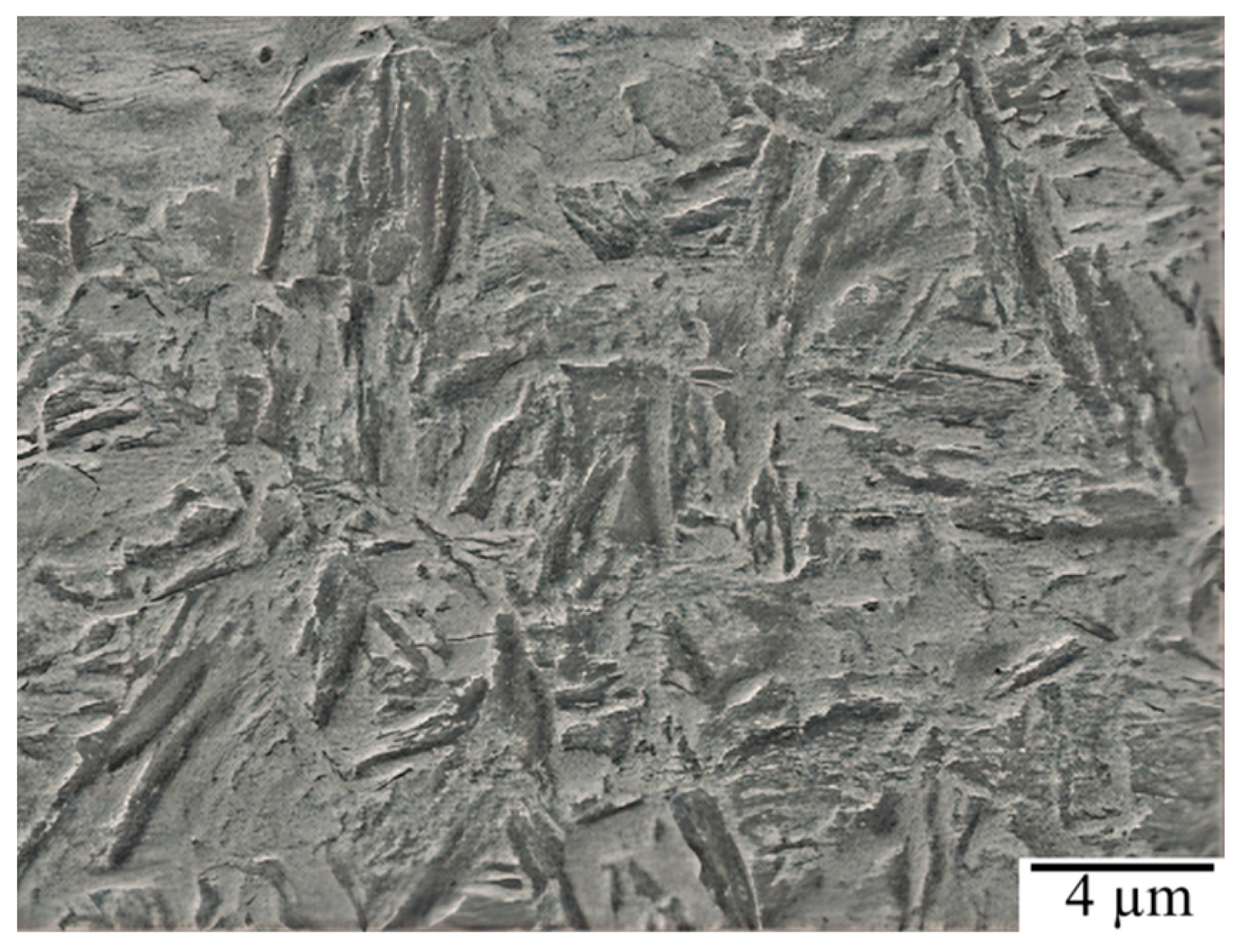

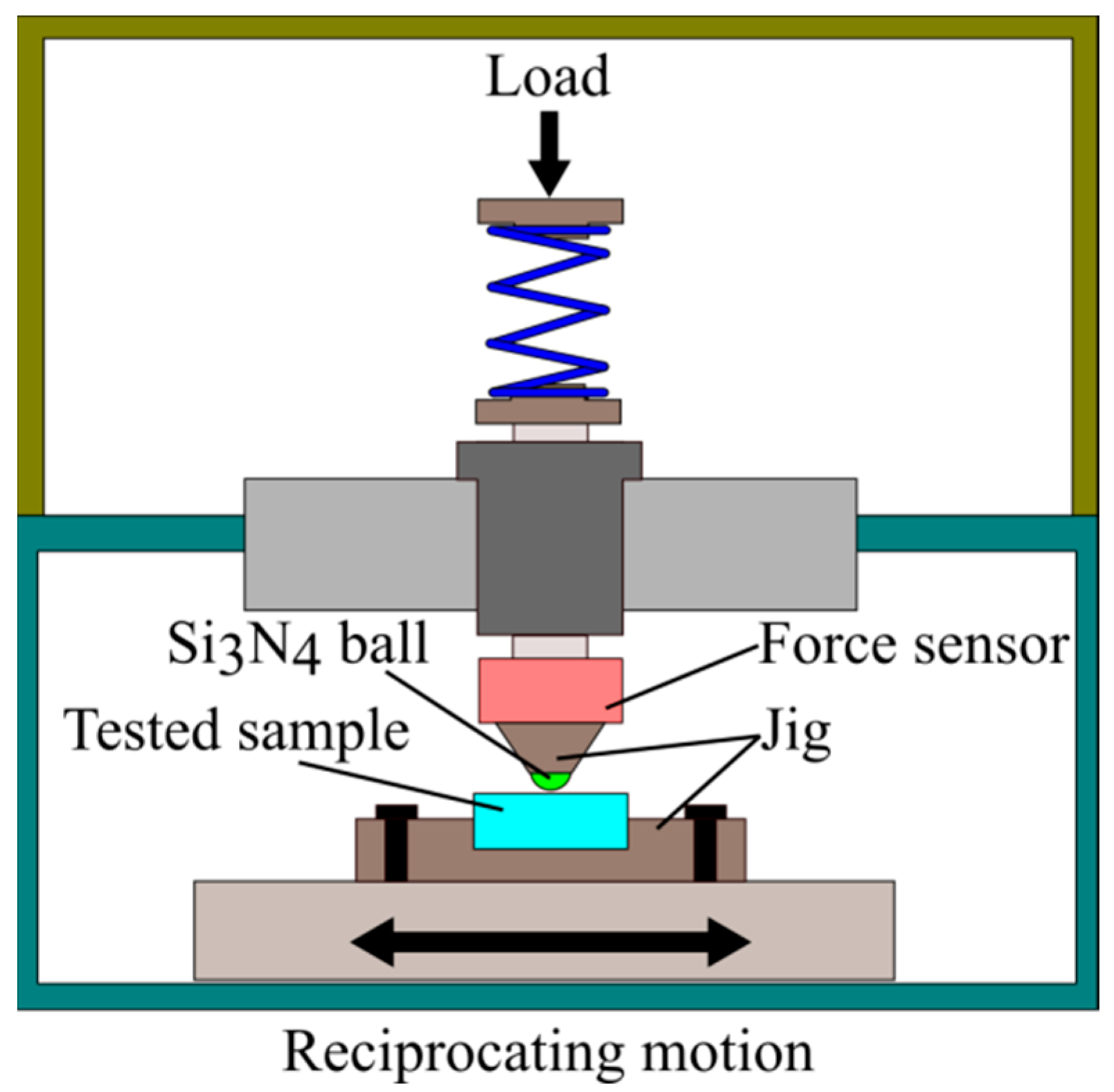

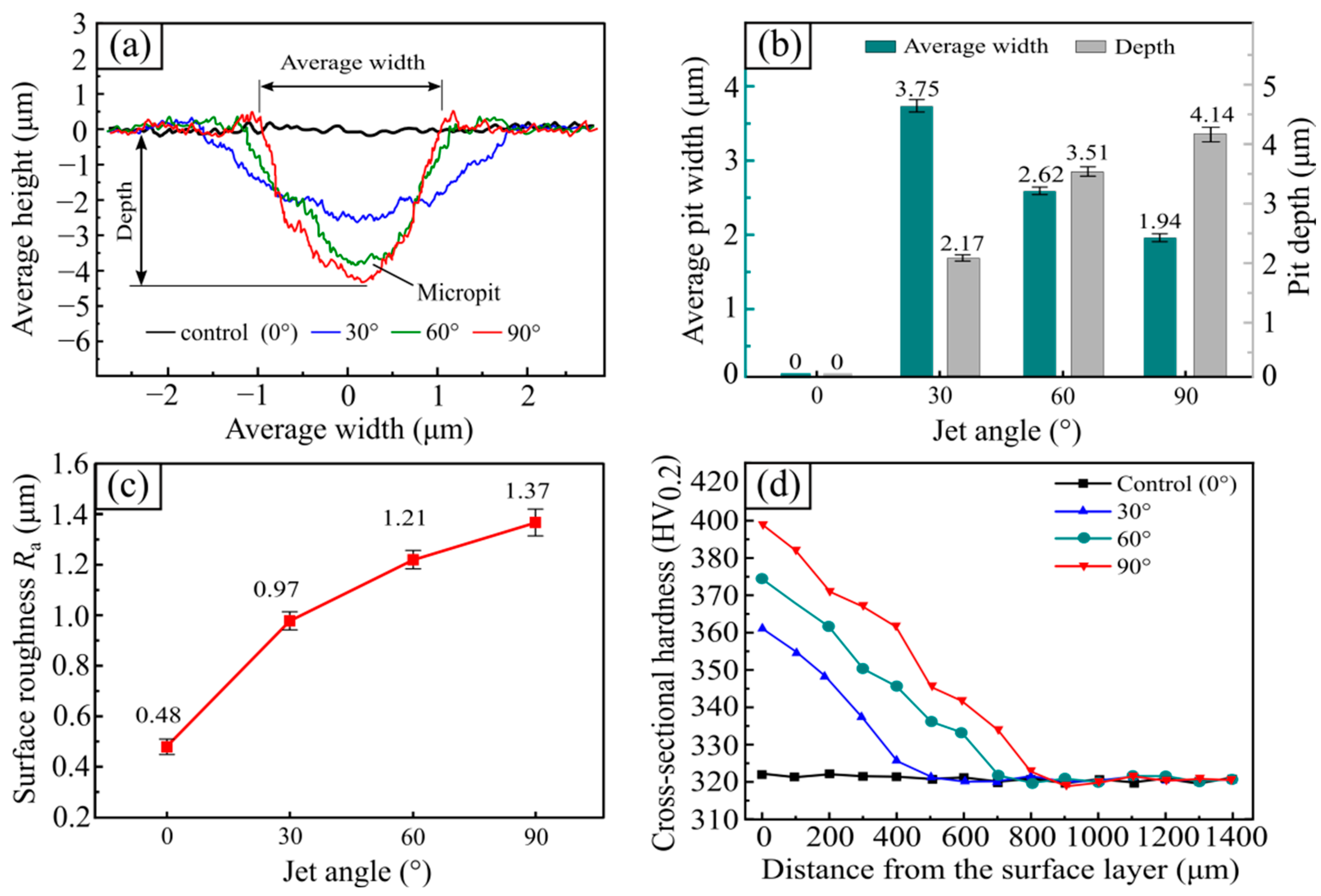

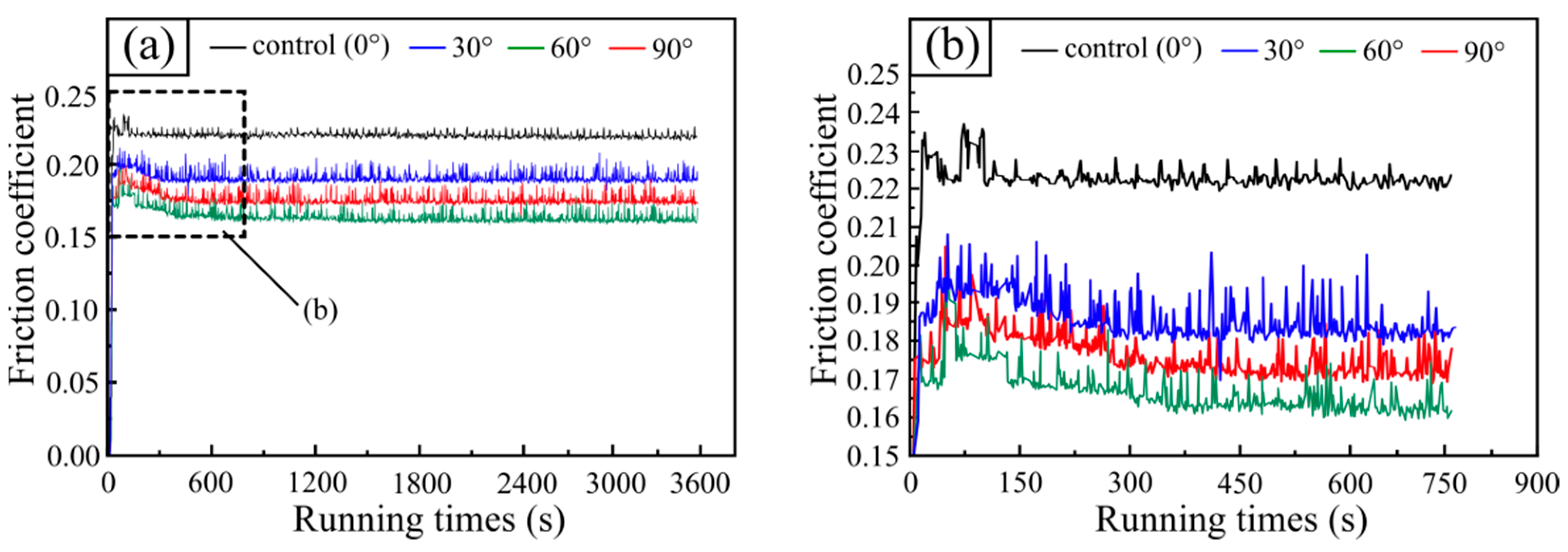
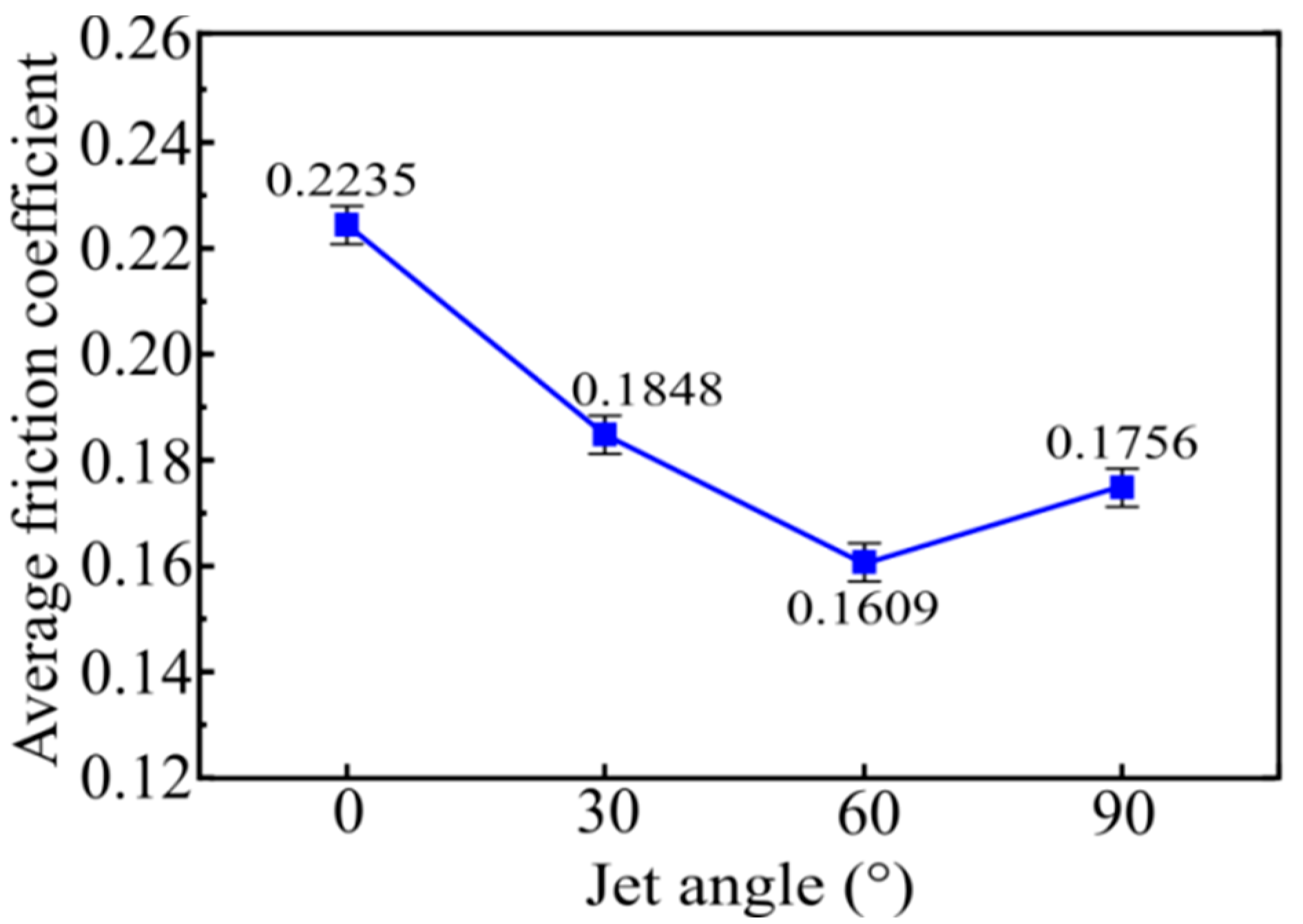
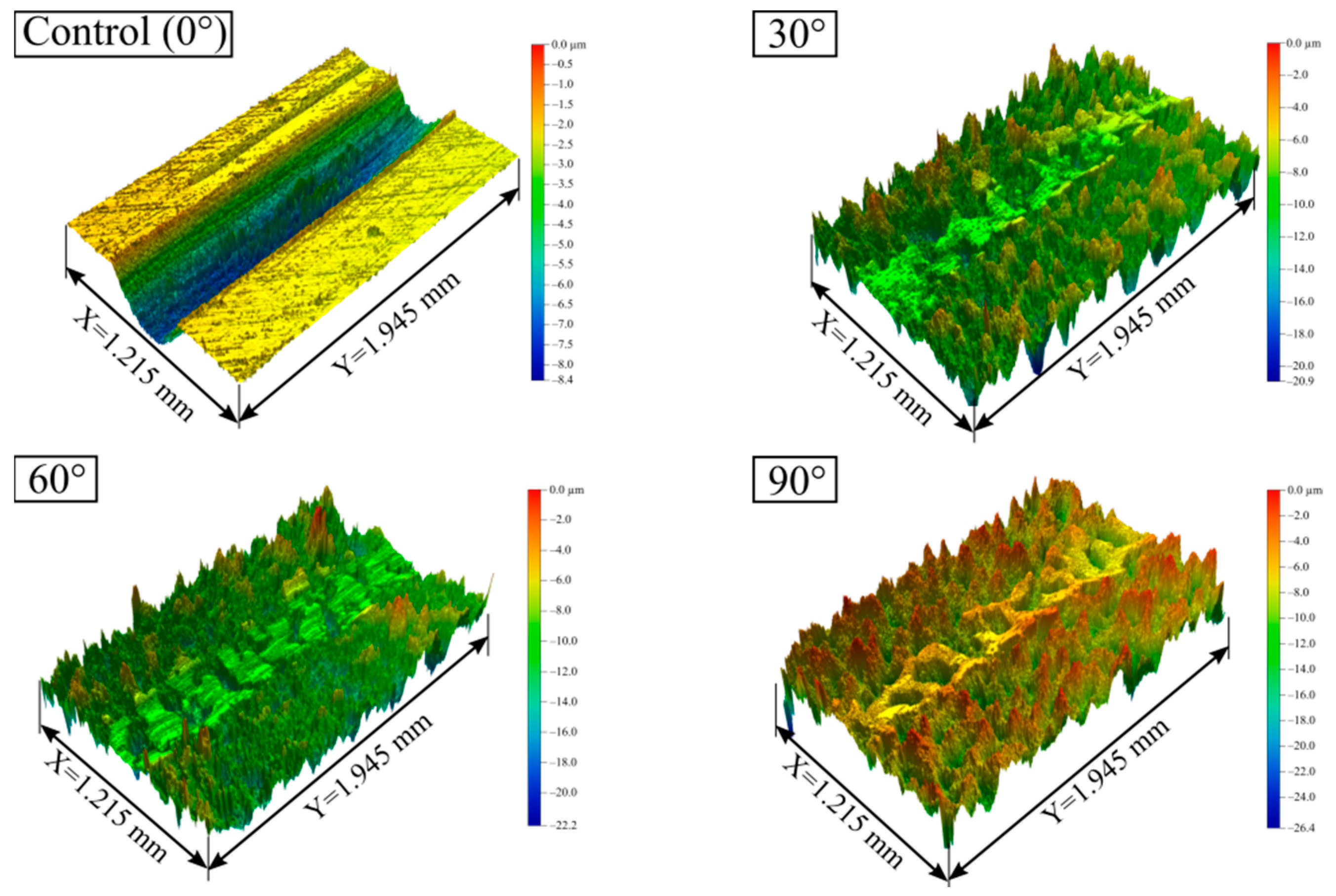



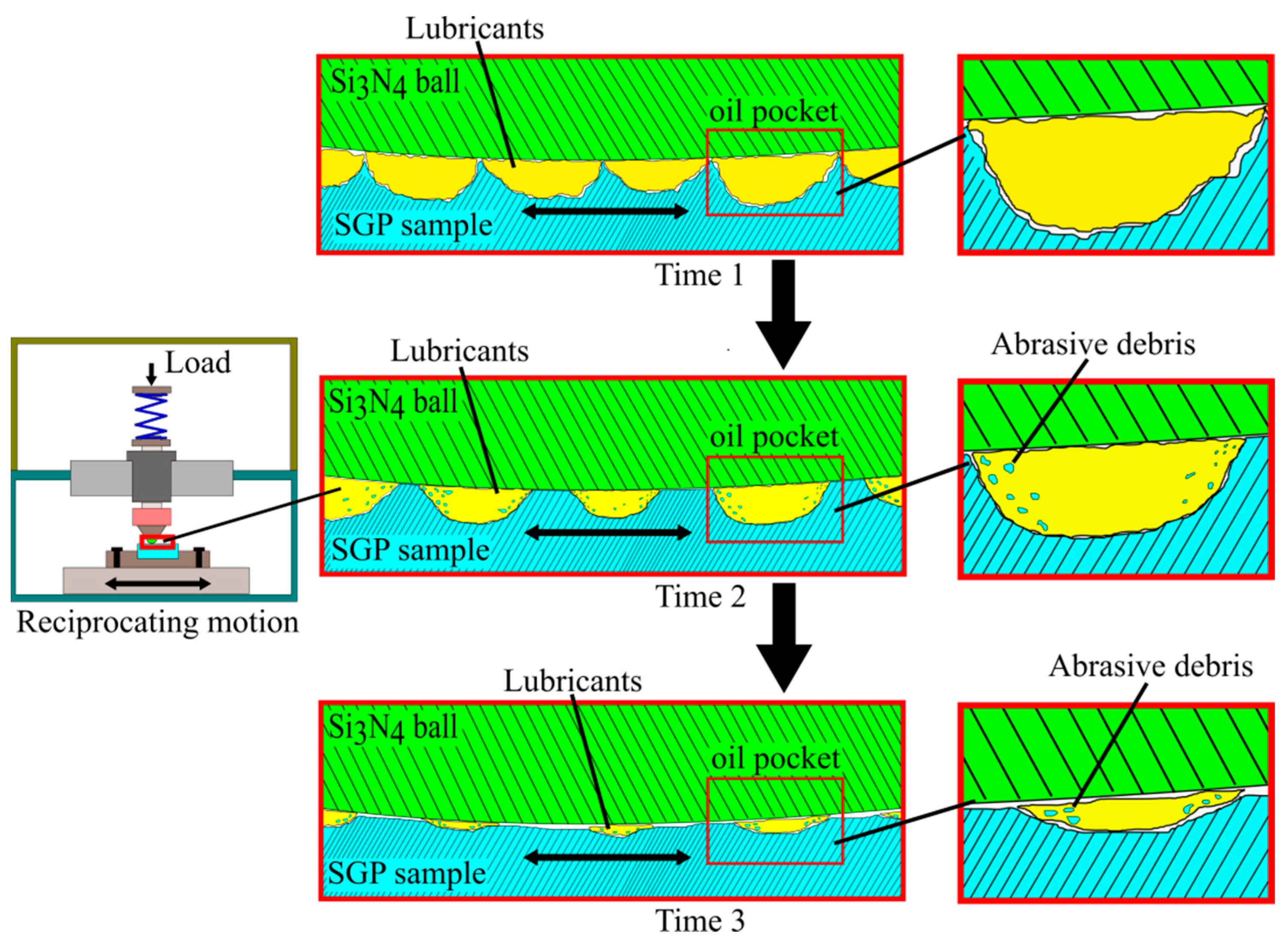

| Material | Cr | C | Mn | Si | S | P | Fe |
|---|---|---|---|---|---|---|---|
| 30CrMnSiA | 0.98 | 0.34 | 0.97 | 1.03 | ≤0.01 | ≤0.01 | Bal. |
| Parameters | Control | Test 1 | Test 2 | Test 3 |
|---|---|---|---|---|
| Jet angle (°) | 0 | 30 | 60 | 90 |
| Jet pressure (MPa) | 0.7 | |||
| Jet distance (mm) | 90 | |||
| Process time (min) | 15 | |||
| Jet Angle | Control (0°) | 30° | 60° | 90° |
|---|---|---|---|---|
| Average oil storage volume (µm3) | 0 | 12.46 | 25.35 | 26.12 |
| Control (0°) | Test 1 (30°) | Test 2 (60°) | Test 3 (90°) | |
|---|---|---|---|---|
| Capacity of oil pockets (μm3) | None | 12.46 | 25.35 | 26.12 |
| Surface hardness (HV0.2) | 322.4 | 361.2 | 374.8 | 397.7 |
| Surface roughness (μm) | 0.48 | 0.97 | 1.21 | 1.37 |
| Running-in time (s) | 130 | 286 | 343 | 378 |
| Average friction coefficients | 0.2235 | 0.1848 | 0.1609 | 0.1756 |
| Wear volume (×10−3 mm3) | 9.04 | 5.79 | 3.82 | 5.53 |
| Specific wear rate (×10−3 mm2/N) | 15.13 | 9.66 | 6.36 | 9.22 |
| Slight abrasive wear | ✓ | ✓ | ✓ | |
| Sever abrasive wear | ✓ | |||
| Slight fatigue wear | ✓ | ✓ | ||
| Sever fatigue wear | ✓ |
Publisher’s Note: MDPI stays neutral with regard to jurisdictional claims in published maps and institutional affiliations. |
© 2022 by the authors. Licensee MDPI, Basel, Switzerland. This article is an open access article distributed under the terms and conditions of the Creative Commons Attribution (CC BY) license (https://creativecommons.org/licenses/by/4.0/).
Share and Cite
Liu, X.; Chen, X.; Liang, Z.; Zou, T.; Liu, Z.; Xiao, J.; Li, D.; Yu, D. The Tribological Properties of 30CrMnSiA Bearing Steels Treated by the Strengthening Grinding Process under Lubrication Wear. Materials 2022, 15, 7380. https://doi.org/10.3390/ma15207380
Liu X, Chen X, Liang Z, Zou T, Liu Z, Xiao J, Li D, Yu D. The Tribological Properties of 30CrMnSiA Bearing Steels Treated by the Strengthening Grinding Process under Lubrication Wear. Materials. 2022; 15(20):7380. https://doi.org/10.3390/ma15207380
Chicago/Turabian StyleLiu, Xiaochu, Xiujie Chen, Zhongwei Liang, Tao Zou, Zhaoyang Liu, Jinrui Xiao, Dongwei Li, and Diaodiao Yu. 2022. "The Tribological Properties of 30CrMnSiA Bearing Steels Treated by the Strengthening Grinding Process under Lubrication Wear" Materials 15, no. 20: 7380. https://doi.org/10.3390/ma15207380
APA StyleLiu, X., Chen, X., Liang, Z., Zou, T., Liu, Z., Xiao, J., Li, D., & Yu, D. (2022). The Tribological Properties of 30CrMnSiA Bearing Steels Treated by the Strengthening Grinding Process under Lubrication Wear. Materials, 15(20), 7380. https://doi.org/10.3390/ma15207380








